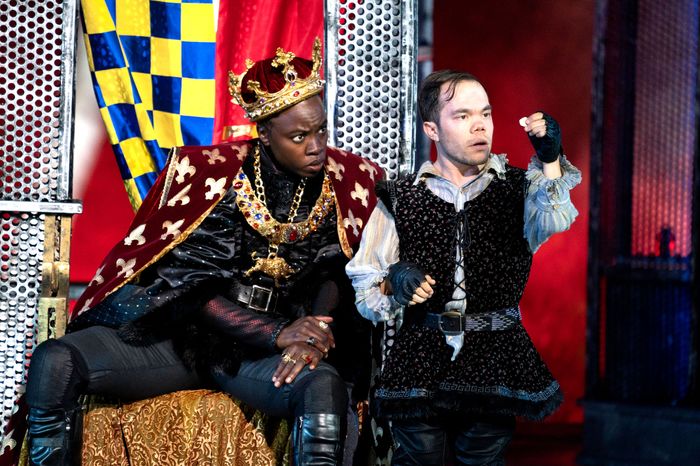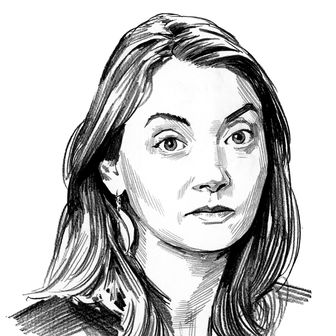
The essential feeling of Shakespeare in the Park is a breeze. Maybe it’s a pretty evening in Central Park and the trees dreamily stir their branches; maybe it’s a hot night and you fan yourself with your program. No matter the show, there’s always some moment when you feel the night moving against your skin. Lighter pieces are easiest, because they sway with the air.
It’s therefore already a challenge to get Shakespeare’s Richard III to work at the Delacorte. It’s certainly a funny tragedy, full of snide asides from the sociopath at its center, but it’s about as breezy as a tornado. The English duke Richard, through trickery and force, rolls like a juggernaut through his own family, murdering right and left, just to reach the crown. The tale requires escalating intensity, tricky to achieve in an environment that’s always trying to lure your attention away. (Look! A duck!) You need tension, clarity, and a meticulously delivered text. Robert O’Hara’s production has ideas — but it is not rich in those other things, and it lets our focus waver.
In an effort to keep the audience’s attention, the glittering Danai Gurira plays Richard with desperation, as though she’s yoked to something heavy: She sometimes shrugs her shoulders forward as if in harness, or she takes a particularly wide turn as if a cape is flaring behind her. Her Richard is an entitled aristo rather than a calculating imp, a swaggering T. rex instead of a darting velociraptor. Her evident grace and glamour vault her over the other characters — on the wide stage, she always attracts the eye. But O’Hara’s baffling production is glue under her black boots; as hard as she tugs, it fights her.
Or maybe the production is fighting itself. Cutting Richard III is always a fraught proposition. You must pare it back (a modern audience won’t follow all 45 characters, many left over from earlier Shakespeare histories), but the minute you think it will be easier to understand if it’s short, you’re sunk. You have to explain some things: Who is this ranting, witchy Margaret? Which Edward just died? (There are several.) If you try to simplify only by cutting to the bone, Richard’s adversaries become interchangeable, and the audience will eventually give up on separating their Buckinghams from their Riverses from their Stanleys.
Here, the creators have pruned all they can, and the thinning-out gets so severe it sometimes leads to absurdity. For instance, O’Hara has radically reduced the scene in which Richard’s ghostly victims each yell at him the night before his last battle. Now the sequence consists of a single up-’n’-down from a stage elevator loaded with dead aristocrats. They rise through the trapdoor in a huddle; they make their angry faces (“grrr”) at the audience as an eerie hubbub plays over the speakers; they sink, still in their huddle, back into the floor. It’s very Disney’s Haunted Mansion.
Yet the cutting isn’t the main issue, not every time. The deepest problems are rooted in O’Hara’s visual storytelling, which rarely clarifies and often confuses. So what does the show look like? Well, this club has everything: stage fog, metal Gothic arches with neon outlines, cousin murder, and an ensemble that twerks at a coronation and then seems embarrassed about it. It’s a late-medieval-but-make-it-sexy aesthetic: Costume designer Dede Ayite puts characters in full Yorkist splendor, though some, like Richard, accessorize their velvet doublets with motocross leathers and tight fades. (Gurira even has little fleurs-de-lis shaved into her hairline.) Movement is often stylized — those arches, from designer Myung Hee Cho, spin on a turntable and light up red as flames — but rarely explains the situation at hand. Mothers don’t touch their sons; victims don’t avoid their killers. It’s hard to tell who is related, even sometimes who is dead.
O’Hara is most interested in subverting Shakespeare’s language about Richard’s body. When the despot accounts for his own villainy, he links it to his “deformed, unfinished” shape — he cannot “prove a lover,” so he’ll break bad instead. Gurira does not pretend to be a hunchback, and O’Hara pointedly casts a company around her with a wide range of abled and disabled bodies, including Gregg Mozgala, the much-awarded actor with cerebral palsy who plays both Richard’s brother Edward and the noble king-to-be Richmond. The Plantagenet court includes several Deaf courtiers, including Richard’s own mother (Monique Holt), who signs her displeasure at her heedless son. That, at least, creates one lovely piece of staging: When Richard turns his back on her, it’s a total refusal — he will not even see her speak. There are exciting thoughts here, if underdeveloped, and I hope some of these same artists (particularly Mozgala) keep playing with them. For now, they’re swamped by the narrative muddle all around them.
O’Hara’s finest moments are when two characters have a nasty little exchange. For instance, Queen Elizabeth (Heather Alicia Simms) and ex-queen Margaret (a scene-stealing Sharon Washington) are tart and viperish with each other, wonderful at torquing Shakespeare’s iambs to sound utterly contemporary. Gurira forms a spiky third with them sometimes, and in these scenes the play starts to catch its rhythm. Way back in 2005, Robert O’Hara directed Gurira in the superb In the Continuum, the protean play Gurira wrote with Nikkole Salter, and it makes sense that he would still be best at the delicate chesswork of interpersonal drama, most comfortable when helping Gurira find detail and humor, particularly when she’s speaking with other women.
Gurira isn’t the only woman playing a terrible guy this week. Just up the Hudson River at Bard SummerScape, Amelia Workman is starring as the famous cad in Molière’s Dom Juan. The two plays have plot points in common: The Spanish seducer also does some murdering and ghost-snubbing, and neither villain ever feels remorse, even as both meet terrible ends. The new translation by Sylvaine Guyot and Gideon Lester moves crisply, and some parts sounded so modern I had to look up my battered old copy, only to discover they were translating faithfully. What a strange and slippery comedy Dom Juan was — and is.
But Ashley Tata’s production runs into some of the same potholes that O’Hara’s does. Casting a charismatic woman as one of History’s Great Heels asks questions of the play and the audience, and a production needs to be ready to confront them. In the case of Dom Juan, the original’s morality hinges on both Dom Juan’s and society’s cruelty to women. The play was censored in its time for its broad critique — since nothing will change the gleeful reprobate, we’ll have to change the hypocritical, brutal society instead. In Tata’s version, though, we can tell that this particular world won’t punish Dom Juan’s conquests; we see the company in a leafy gender-fluid paradise and not Molière’s clear-eyed version of his own milieu. Even several rapier performances (particularly Jordan Bellow as a put-upon ex-monk, Tony Torn as a cheated tradesman, and Zuzanna Szadkowski as an exhausted Sganarelle) cannot give the play back its danger.
The Public’s Richard doesn’t have that exact problem — Gurira’s character has so many assassins on retainer, he doesn’t need misogynist social censure as an added weapon. But the casting is one of the many instances of the play saying one thing and the production showing us another. Families do not look like each other: Okay, yes. But when they don’t act like families? Words and images sometimes mean their opposites here, and it’s not always clear when that’s true. Richard shows the group his “withered” arm, but it is obviously not twisted; he complains a lack of beauty has made him a pariah, but anyone can see how Gurira outshines the moon. Were O’Hara’s storytelling more confident, were the relationships more clear, we could afford more of this anti-illustration. But if the audience isn’t sure who is who to begin with, that strategy — so provocative, so delicious, so risky — makes a glorious summer in the Park feel chilly with a certain discontent.
Dom Juan is at the Fisher Center at Bard College through July 17.
Richard III is at the Delacorte Theater in Central Park through July 17.


